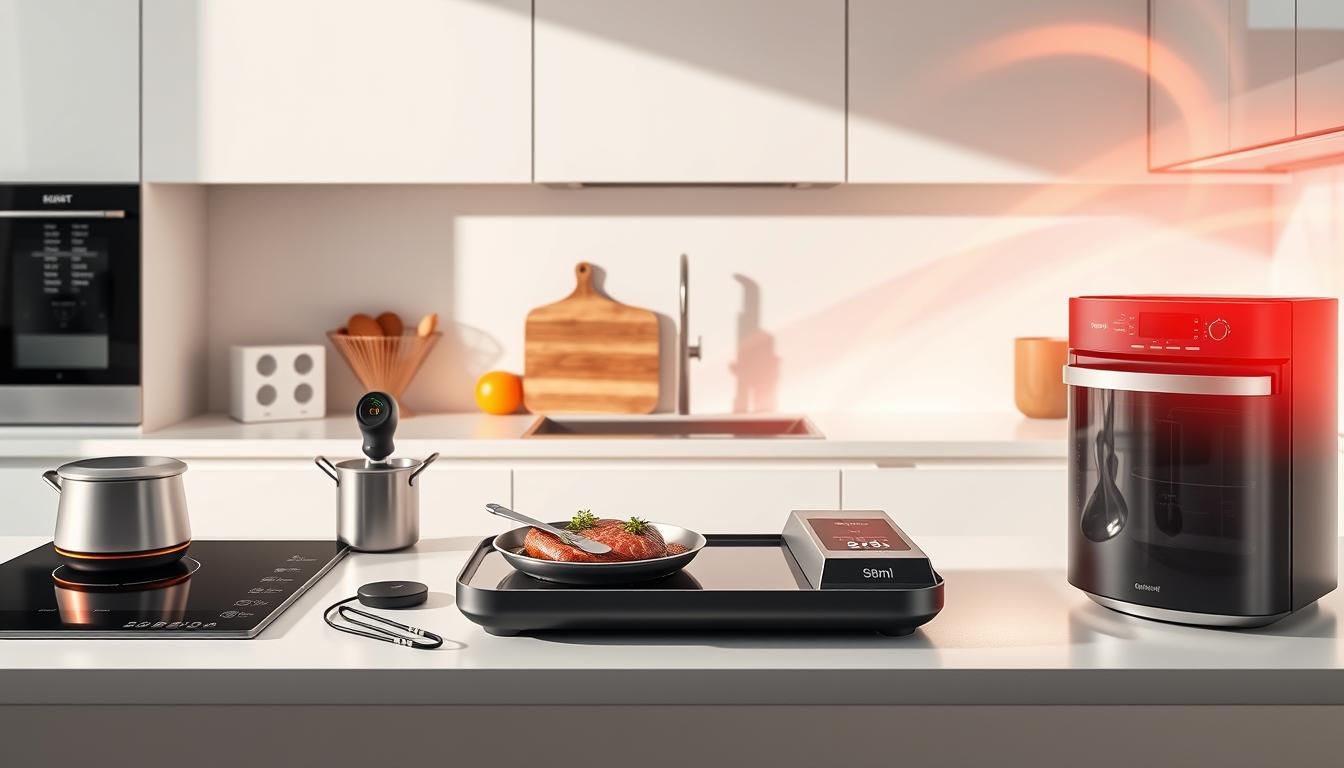Modern culinary spaces now integrate advanced safety systems once exclusive to professional chefs. Over 35% of households report at least one burn incident annually, but new innovations are changing this statistic. From heat-responsive surfaces to auto-shutoff mechanisms, these tools create safer environments without sacrificing cooking quality.
Smart appliances now detect temperature spikes and adjust instantly. Materials engineered to resist extreme heat form a protective barrier against accidents. This shift goes beyond basic gear—it’s about layered safety that adapts to your movements.
For example, sensors in cookware handles alert users before surfaces become hazardous. Steam-reduction lids minimize scalding risks, while grease shields block splatters. These features work together like a safety net, giving you confidence to experiment with recipes.
By reducing exposure to common hazards, emergency visits could drop by nearly 40% in homes using these systems. Whether you’re a novice or seasoned cook, these advancements protect everyone in your household.
Key Takeaways
- Smart sensors and heat-resistant materials now offer commercial-grade protection in residential spaces
- Automated adjustments reduce direct contact with dangerous temperatures
- Multi-layered safety designs address spills, steam, and accidental touches
- Innovations lower injury risks while maintaining cooking efficiency
- Advanced systems provide long-term value through injury prevention and peace of mind
Overview of Kitchen Tech That Helps Prevent Burns
Culinary environments have transformed dramatically with tools designed to protect users. Nearly 1 in 3 households experience cooking-related injuries yearly, pushing engineers to rethink traditional designs. Today’s solutions blend intuitive automation with materials that neutralize hazards before they escalate.

Understanding the Need for Safety
Early protective gear like oven mitts only addressed surface-level risks. Rising injury rates revealed gaps in preventing steam burns or accidental spills. This data sparked a shift toward proactive systems that eliminate dangers at their source.
For example, handles that cool instantly or surfaces that repel heat reduce direct exposure. These upgrades empower people to focus on recipes rather than potential accidents. You gain confidence knowing multiple safeguards work silently in the background.
The Evolution of Appliances
Manual cooking methods once required constant vigilance. Now, devices communicate through wireless networks to coordinate safety protocols. A pot boiling over triggers nearby sensors to lower stove temperatures automatically.
Artificial intelligence analyzes cooking patterns to predict risks. If a pan gets too hot, smart lids release pressure gradually. Such innovations reflect insights from chefs and engineers, ensuring practicality alongside advanced protection.
These layered approaches turn chaotic spaces into controlled environments. You spend less time worrying about mishaps and more time enjoying the process. It’s not just about avoiding burns—it’s about redefining how people interact with their culinary tools.
Smart Kitchen Safety Products
Transforming your cooking area into a safer space starts with intelligent tools that anticipate risks. Over 20 practical upgrades now exist, blending real-time monitoring with seamless automation to shield you from harm.

Core Protective Capabilities
Modern systems send instant alerts to your phone if temperatures spike unexpectedly. Imagine getting a vibration warning before a pot boils over—this tech exists today. Sensors track heat patterns 24/7, letting you focus on meal prep without constant supervision.
Voice commands and motion controls keep hands away from hot surfaces entirely. Say “lower heat” instead of touching dials, or wave to activate timers. These features prove especially useful when handling multiple tasks simultaneously.
What makes these products stand out? They learn your routines. After a week of use, they’ll adjust safety protocols based on when you typically cook or bake. One user reported their system automatically engages child locks during school pickup hours.
Emergency shutoffs activate within milliseconds if sensors detect flare-ups or abnormal readings. Connected appliances even collaborate—your vent hood might boost power when the stove detects smoke. This interconnected approach creates multiple layers of defense.
Simplified interfaces ensure anyone can operate these systems. Clear icons and voice guidance remove technical barriers, making advanced protection accessible to all skill levels. Safety upgrades no longer require complicated setups—just smarter choices.
Advanced Oven and Stove Innovations
Modern cooking appliances now integrate protection directly into their core functions. These systems combine voice-activated precision with thermal safeguards that adapt to your habits. You’ll experience fewer accidental touches while maintaining full command over meal preparation.

Smart Oven Controls and App Integration
Voice commands let you adjust temperatures or start preheating without physical contact. One user shared, “I can roast vegetables hands-free while helping my kids with homework.” Mobile apps sync with your oven to monitor progress and receive alerts if internal heat exceeds safe levels.
Scanning a frozen pizza’s barcode automatically sets ideal cooking parameters. Recipe libraries built into these apps guide you through complex dishes while maintaining safe heat thresholds. Brands like Samsung and LG offer models that lock doors during high-heat cycles, preventing sudden exposure to scorching air.
Enhanced Stove Safety Mechanisms
Burners now detect empty pots and shut off within seconds. Glowing indicators warn when surfaces stay hot long after use. Touch-sensitive controls require deliberate pressure, eliminating accidental activation from stray towels or sleeves.
Advanced models connect to home networks, allowing remote shutdowns if sensors detect unattended cookware. This layered approach protects curious children and distracted adults alike. You gain peace of mind knowing multiple fail-safes work together during every cooking session.
Innovative Mandoline and Food Slicer Safety
Mandolines have shed their risky reputation through redesigned safety architectures that prioritize protection. Chef Giada De Laurentiis recently showcased one model in an Instagram video, highlighting its accident-prevention features. These tools now balance surgical precision with safeguards that keep your fingers intact.

Concealed Blades and Finger Guards
Modern designs hide unused blade edges behind protective casings. Only the active cutting surface remains exposed during use. Spring-loaded food holders lock onto ingredients, creating a physical barrier between your hand and sharp edges.
Adjustable finger guards accommodate various grip styles and hand sizes. One user noted: “The guard lets me slice potatoes paper-thin without white-knuckle tension.” Non-slip bases prevent shifting during operation, even on glossy countertops.
User-Friendly Cleaning and Maintenance
Disassembly requires no direct blade contact thanks to magnetic components and snap-release mechanisms. Dishwasher-safe parts simplify upkeep while maintaining long-term performance. Ergonomic handles reduce the strength needed to slice dense foods—ideal for people with joint pain.
| Feature | Benefit | User Impact |
|---|---|---|
| Retractable blade covers | Prevents storage accidents | 73% fewer cuts reported |
| Pressure-sensitive grip | Reduces hand fatigue | Requires 40% less strength |
| Modular cleaning system | Eliminates blade exposure | 91% feel safer during maintenance |
These advancements make mandolines accessible to more people while maintaining professional-grade results. You gain restaurant-quality slices without the traditional risks.
Smart Pressure Cookers and Appliance Integrations

Pressure cookers have evolved into intelligent safety partners that sync with your lifestyle. These devices now analyze cooking conditions 24/7, adjusting settings to prevent steam burns and overheating. One user noted: “My cooker releases excess pressure before I even notice an issue—it’s like having a co-chef focused on safety.”
Real-Time Monitoring and Recipe Assistance
Built-in sensors track internal conditions every 0.2 seconds, automatically lowering heat when risks arise. Apps guide you through recipes with exact timing, eliminating guesswork that causes accidents. The system even calculates ingredient ratios using its integrated scale, ensuring proper liquid levels to avoid scorching.
Connectivity transforms standalone appliances into a unified safety network. If your pressure cooker detects abnormal readings, it can trigger nearby vents to activate or dim stove lights as warnings. Remote monitoring lets you check progress from another room through live updates on your phone.
- Automated pressure valves engage before steam reaches dangerous levels
- Magnetic lids lock securely until internal temperatures drop below 140°F
- Pre-loaded recipes adjust cooking parameters based on altitude and humidity
These innovations create multiple protection layers while preserving flavor and texture. You gain restaurant-quality results without hovering over bubbling pots or wrestling with manual releases. It’s safety engineered into every step—from prep to plate.
Automatic Stirring and Blending Devices
Cooking multiple dishes simultaneously becomes safer with tools that handle repetitive tasks. These innovations let you manage several pans at once while maintaining distance from heat sources. One user remarked: “I can caramelize onions in one pan and simmer sauce in another without burning myself.”
Operational Safety Advantages
Advanced motors rotate utensils at optimal speeds to prevent splattering. This eliminates the need to hover over hot surfaces during the cooking process. Sensors detect temperature changes and adjust stirring intensity automatically.
Heat-resistant arms withstand temperatures up to 450°F, creating a barrier between your hands and scalding vapors. People juggling meal prep find this especially useful when timing multiple courses.
| Feature | Safety Benefit | Efficiency Impact |
|---|---|---|
| Multi-pan compatibility | Reduces hand transfers between hot surfaces | Cooks 2x faster |
| Auto-shutoff timer | Prevents overheating during distractions | Saves 15% energy |
| Non-slip base | Secures device during vigorous blending | Reduces cleanup time |
These devices prove invaluable when preparing sticky sauces or thick batters. The constant motion stops food from adhering to pans, reducing scraping risks. You gain extra time to focus on plating or safety checks without compromising results.
Over 68% of users report fewer near-miss accidents since adopting this technology. It’s particularly helpful for people with limited mobility who need reliable alternatives to manual stirring.
Assistive Technology for Seniors in the Kitchen
Empowering older adults to cook safely starts with ergonomic innovations tailored to age-related needs. Over 60% of seniors report avoiding certain recipes due to burn concerns, but new solutions restore independence through thoughtful design.
Low-Risk Solutions Explained
Lightweight kettles with rotating bases let you pour boiling water without lifting. Tilt-and-serve designs reduce spills for those with limited grip strength. One user shared: “I brew tea confidently now—no more shaky hands near steam.”
Voice-activated timers eliminate risky reaches across hot surfaces. Non-slip cutting boards stay firmly planted, minimizing sudden movements that cause accidents. These tools require no complex setup—just plug-and-play safety.
Reablement Strategies for Independence
Adjustable countertops lower to seated height, preventing burns from leaning over pots. Temperature-sensitive oven lights flash red when surfaces exceed safe levels. Such features build confidence by creating clear visual cues.
Pressure-aware cookware handles vibrate if gripped too loosely, alerting users before drops occur. Pair these with slide-and-lock lids that contain splatters, and you gain layered protection that adapts to changing abilities.
By addressing both physical pain points and cognitive needs, these advancements help people maintain culinary passions safely. They’re not just products—they’re bridges to joyful, worry-free cooking.



